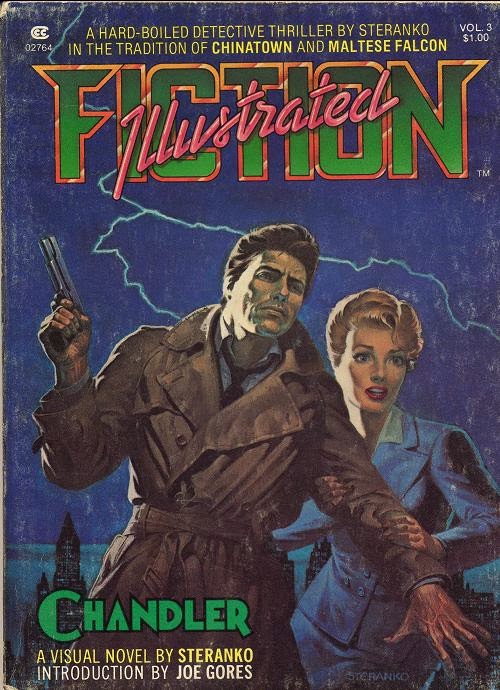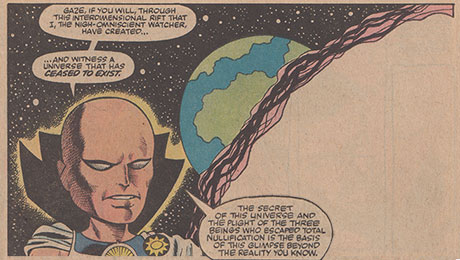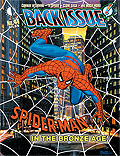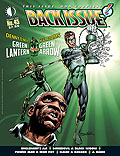
Welcome to our second guest post! This past Monday Mike W. walked us through one of his favorite story arcs of the early 1980s, a tussle featuring the Justice League and Justice Society against a revamped Secret Society of Super-Villains. Today we have a Bronze Age reading of a different stripe -- an illustrated novel. Your host for this literary excursion is Edo Bosnar.
Edo Bosnar: A big
part of what we call the Bronze Age in comics was the experimental stuff. Not
just the often trippy or off-the-wall stories in mainstream superhero comics by
guys like Jim Starlin or Steve Gerber, but also the various innovative projects being
published by someone other than Marvel or DC. An example of this is the Fiction
Illustrated series launched by Byron Preiss in the mid-1970s. These were
supposed to herald a new age in graphic storytelling. You
can see the entirety of one of these offerings, Starfawn, over at Diversions of the Groovy Kind.
Another, and perhaps the best remembered, is Chandler: Red Tide by the
legendary Jim Steranko.
It’s
a hard-boiled/noir detective story set in New York the early 1930s, featuring a
P.I. named Chandler (an obvious homage to Raymond Chandler). Steranko did
pretty much everything but the coloring in this, i.e., he wrote the story, drew
all of the illustrations and very meticulously designed the whole package.
I’m
not going to do a full review of the story, since it is a novel, or rather, a
novella. Whatever the matter, a full rundown would be too time-consuming.
Needless to say, it’s got all of the elements of a classic hard-boiled crime
novel in the style of Chandler or Hammett: a tough private detective drawn into
a bizarre murder case (a guy comes into his office saying he’s got 72 hours to
live because he was poisoned, and wants the detective to find his murderer),
and on the way there are intrigues involving organized crime and uncooperative
police officers, a few plot-twists, including a bit of shocker at the end, and,
of course, a femme fatale.
What
I really want to do here is just highlight the book itself. Steranko wanted to
make this look like something that’s halfway between a comic book and a
standard prose novel. As you can see, there are pictures all the way through, and
under each there are always exactly 13 lines of text, so it has a very uniform
and well-ordered look throughout. Some
of my favorite pages are those in which each of the panels forms an entire
“splash” image. Like this flashback sequence:
It’s
notable that Steranko really made an effort for this to be a genuine
juxtaposition of words and pictures, rather than the sequential images with
narration and/or dialogue inside the pictures that you get with comics. This
actually sets it apart from the only other Fiction Illustrated title I’m
familiar with, the above-mentioned Star Fawn, which does have occasional
dialogue bubbles as in standard comic books.
I
think Steranko mostly succeeded in his aim, as this is a really cool-looking
book. The story, while nothing spectacular, is solid. It’s too bad he didn’t do
a few more of these, just as it’s unfortunate that these didn’t catch on and
become more popular. Preiss and a few others did make some later, similar
attempts (most notably with Howard Chaykin), and while well-liked by fans and
cult favorites now, they ultimately didn’t set the world on fire. All
in all, this is an interesting relic of a time when a number of creators were
trying to stretch the limits of what comics and graphic storytelling could be.
By
the way, my copy is the original pocketbook format printed on newsprint-type
paper, which I purchased online pretty cheaply about 6-7 years ago. Apparently
there was also a deluxe edition, which was 8” x 10” in format and printed on higher-quality
paper – the few times I’ve checked (e.g. on eBay), copies of that, when
offered at all, are never listed for less than a $100. Ouch. Unfortunately, it
doesn’t look like we’re going to get some nice, new deluxe reprint, either: a
few years ago, several comics-related websites posted announcements that
Chandler would be reprinted by Titan Books, but so far nothing has come of
this.

























































28 comments:
This. . . is a great, great style for Steranko! Man, visually he absolutely captures film noir on the page. In some ways, better than maaaany of those films themselves did (it was a genre that a had a ton of band-wagon jumping wannabees).
Of all things, what it does bear a resemblance to, format-wise, is Prince Valiant. Not in tone or style or content, mind you, but simply in the convention that it is pictures supported by separate blocks of text-- and no within-the-image dialog.
I've never heard of this, edo, this is great stuff!
HB
This is absolutely top of my list for Comics I Still Don't Have But Desperately Want ( mainly so I can post the whole thing on my blog! )
There's an interview on youtube with Steranko where he talks about re-releasing it in a deluxe version, but I think it's from a while ago and, as you say, it hasn't happened yet.
Ludicrous really, 'cos even with the few pages I've seen, it's obviously a tour de force.
Magnificent job on this overview, Edo! You covered all the things that made this classic so cool. You choice of images was wonderful, as well. I love that you played up the angle of folks trying to expand the boundaries of comics during the 70s. The variety of formats we got during the 70s was unlike any other time in history.
Oh, yeah, I'm sure someone's gonna mention how Steranko's art here inspired Frank Miller's Sin City style (you can really tell it when you see Sterankos pages in b&w), so I just beat 'em to it! ;D
Thanks for the review Edo. This book looks amazing, and I had no information about it prior to this post.
I think the scene in which the gunman is on the boat is incredible. It is interesting how Steranko gets the reader to refocus on each of the elements by separating a splash into the panels. First you look at the killer, then the victim in the foreground, then further back at the man collapsing, and then the woman on the ground with the man kneeling. If combined, the focus would surely be the man in the foreground and I believe on quick perusal the background elements get lost in a combined artwork. Steranko's method creates the feeling of being a witness, and seeing all of the panic and chaos and terror. I focused on each element and that elevates the mood. Very impressive.
Wasn't one of Steranko's concerns about his work at Marvel around the placement of the words? Didn't he want text to be outside of the panels so that it would not interfere with the art or create a five sided panel (as he called it) because the box of text created an extra edge? I may have that wrong. I am assuming this was done after all of that and his final work in the horror title at Marvel. What year was this published?
Again, much appreciated review Edo.
I had no idea Chandler was so hard to find (any chance you might want to buy mine for a ton, Pete?)
Seriously though - I really like the book too, but I've got a total critical blind spot when it comes to Steranko. I think it would be fair to say the writing is a bit weak, that its more a series of hard boiled noir clichés than a story. Which is fine by me, cause I'm mad for Steranko, but maybe explains why Chandler didn't find an audience.
HB - The format of those early attempts at "graphic novels" might well derive from the old newspaper Sunday format - certainly I'd say in the case of Hogarth's Tarzan book - but I think it owed more to the felt need to distance them from comics. You know, of course these are for big people - look, no word balloons.
Maybe that's why they don't seem to be well regarded these days, although personally I have a real fondness for the format.
-sean
"EDO..!! EDO..!! EDO..!!"
(..the BAB community townfolk have been stirred up outside my office window...., marching, chanting.., probably on their way to Starbucks for more caffeine)
Love Steranko, can't wait to read this further, looks like an awesome review. All the scans are great, nice touch for today's subject. Agreed with Groovy that it was a time where artists truely set out to create new images, new concepts within the 'old-school' business and editorial boundaries.., new unchartered territory was indeed ventured upon. Glad to hear our dear Steranko was one of the premier frontiersmen.
I'll certainly have to pick this up.
Aw, shucks, guys - you're making me blush! But thanks for all the comments.
Sean, regarding the story: while I'm not as critical as you are, I would agree that it's pretty by the numbers.
One of the reasons why I think it's a pity that this "illustrated fiction" idea never took off is because I would have loved it if Steranko had given this treatment to some of the classic noir/hard-boiled detective stories. Can you imagine reading, e.g., Hammett's Red Harvest, The Maltese Falcon or (my favorite) The Glass Key with every page illustrated in this fashion by Steranko? And why stop with Steranko? I could also see artists like Chaykin, Kaluta or Wrightson doing stuff like this.
Sitting here reading leisurely for a Thursday: snow day! 10 inches overnight here...
Edo- great job on this review; and a terrific choice of subject! I had this book back in the day, but don't remember it well. Your scans really highlight the beautiful job Steranko did with his images. Those double page spreads are truly beautiful. You mentioned Steranko did everything but the coloring, did the colorist get credited? Nice job in that area as well. Must reacquire this book, for those pages alone if nothing else!
Sean- good point about the attempts in the Bronze Age to distance themselves from "comic books". I'd say it is only in the last 10 years or so that, here in the U.S at least, comic literature (how's that for uppity language) has really started to gain public respect. This, mainly due to the influence of Hollywood. But yes, the mid to late 70s were ripe with experimental formats and subject matter. Within two years of Chandler's publication, we would see Eisner's "Contract With God" hit the shelves...
Edo and Mike W. --
Forgot to mention it when Mike's guest review ran on Monday, but you guys have been added to the BAB Library of Reviews, to live in immortality!
Redartz --
You're in the Louisville area now, right? My son is supposed to be heading that way with the Illinois State U. softball team for a weekend tourney. Slim prospects for that, huh?
Doug
Doug- yes, weather here is dicey. Louisville airport got 11.5 inches, areas sourh of town up to 18 inches. We 'only' got 10 inches...gave me the chance to enjoy Edo's review, and to leaf through the Fantastic Four Omnibus that just came in the mail!
I actually got a text from him that said their Friday games were canceled, Saturday/Sunday up in the air. Sounds like that will be out, too. So time well spent for you!
To all -- I've tweeted the link to today's post at the man himself, Jim Steranko. I'll do it again later today. How cool would it be if he stopped by?
Doug
Edo - Firstly, I should have said you did a good job with the post, so well done.
Don't think we disagree - "pretty much by the numbers" sounds about right to me. Didn't intend to come across as overly critical of Chandler; its more that I was thinking about why it didn't do too well at the time. I reckon an adaptation of something like Red Harvest might well have been more successful.
That "visual novel" format - I think that's what they called it at the time - really needs good writing. Comics do too of course, but the separation between art and text means something like Chandler needs to work a bit harder to involve the reader... but again I'm coming across as too critical, because I love Steranko - if he designed cereal boxes, that's what I'd have for breakfast every day - and I do actually like that format.
(Btw You don't need to imagine Chaykin doing that kind of thing - check out Empire, the book he did with Samuel Delany)
-sean
Good review Edo, and great choice! I picked this up a couple years ago, and even though I'm not a huge Steranko fan I like his work here. Yes it would've been great to see him do more of these.
I find this format with the text below not as enjoyable to read as a comic with word balloons, but it does make for some beautiful clear images. Gil Kane's Blackmark was interesting but also awkward to read, even though that did have some balloons.
Edo - Firstly, I should really have said you did a good job on the post - well done.
I don't think we disagree at all - "pretty much by the numbers" sounds about right to me - so if I came across as more critical of Chandler that wasn't my intention. Rather, I was wondering why it wasn't more of a success with the wider audience the format was aimed at.
An adaptation of something like Red Harvest might well have fared better; that "visual novel" format really needs good writing. Comics do too of course, but the separation between image and text means that a book like Chandler has to work a bit harder to involve the reader... but there I go again, sounding all critical, when I do really like the format.
Btw You don't need to imagine Chaykin using it - track down an old copy of Empire, the book he did with Samuel Delany.
-sean
Oh, I have Empire, Sean (as well as Swords of Heaven, Flowers of Hell). What I meant was that it would have been cool to see Chaykin - and those other artists I mentioned - do adaptations of old detective novels specifically. Chaykin in particular would have been suited to this, because he is really fond of doing stories set in New York in the 1920s and 1930s. (And before you mention it, yes, I have his two Time Squared graphic novels, too.)
Oh right, I get it, Edo. It did seem odd you wouldn't know Empire.
Yeah - Chaykin's really good at the whole 30s/40s pulp thing. Don't know if anyone does it better.
-sean
Great work, Edo. I had never seen this before. I really wish Steranko had done more for Marvel. I have seen so little of his art. He truly is a graphic artist -skilled at a number of techniques, obviously. The way he inspired others is readily apparent.
I'm glad you could bring something different to the blog -and look forward to more guest posts!
Good job, Edo. I love Raymond Chandler's stuff, so I'd probably like this too. And your idea of other comic book artists illustrating noir/detective fiction is great...how about Gene Colan? He'd do the noir-ish stuff perfectly.
Mike Wilson
Martinex, unless he did more horror work afterward, could you be referring to a brilliantly creepy, hard-to-pin-down story Steranko did in Tower of Shadows #1? Scary old mansion, stormy night, dead uncle in a ghastly portrait, simpering nephew w/ greedy shrew of a wife, and. . . time travel-??? So little is fully explained, and yet the reader is able to connect the minimal dots to wonderful and goose-bumpling effect! (It's one of my favorites of the genre-- and probably one of my favorite Steranko works as well-- save the cover for Incredible Hulk Annual #1)
HB
PS-- HBGirl & I have enjoyed a snow-day binge-watching both FRINGE and MEDIUM. . . ! We are indeed utter wastes of viable humanity-!! ('scuze me, I'm *urp* burpin' Costco pizza, here. . . )
Hiya
Thank you very much for reminding me of this book's existence. I vaguely remember a plug for it in some Bullpen's Bulletins that I glanced at.
Looking at it I'd have to concur with those who believe that it was a good idea that time had not yet come when it was originally published. Heck, even Road to Perdition failed to sell the hoped for numbers.
Thanks for the good memories.
pfgavigan
Hiya
Hey Humanbelly, I think the story that you refer to was "At the Stroke of Midnight" from Tower of Shadows 1#. And I'm pretty sure it was done as a short movie a long time ago. Can't quite remember how good it was (or wasn't).
Any how, here's a link to the story online. Bitdefender says the site is safe. There's another story with the same title from the Fifties right before it, but it's there.
http://raggedclaws.com/2011/05/04/look-here-read-midnight-double-feature/
Thanks for your kind attention.
pfgavigan
HB, yes, thank you, that is it. My understanding, and I may be weak on the details, is that Steranko was supposed to take over Tower of Shadows... that was supposed to be his book. That first issue is however the only one he worked on. And I am pretty sure that is either his last work at Marvel or very close to his last work. And if my memory serves me, he had designed a cover (not the one used) that was very cutting edge. He also had some issues with the title used for the story; he and Stan had a disagreement about that. And he also would have liked the words placed differently around the panels (he did not like caption boxes and tried to avoid them). Again, not sure of all of the details but it came to a head. Steranko lost the battle on title and cover art and it ended the relationship. (I also seem to remember reading Stan expressed some regret later). But in that story, there are definitely some fantastic elements where the panels are broken across a splash. It was similar in some ways to the Chandler example. And I was curious about the dates of both of those works. I would have loved to see Steranko do more horror/mystery/suspense work.
As a note of interest pertaining to our topic today, Mr. Steranko will be a featured guest next weekend at the Indiana Comic Con in Indianapolis. Doug and I both attempted to attend this show last year, unsuccessfully. Am thinking of giving it another try this time around...
Nice review Edo ol' buddy!
Well ya gotta give kudos to Steranko for doing something that's not your typical comicbook tale. It's always a good thing to see artists experimenting on new and creative ways to tell their stories. Personally, I was never a big fan of the detective noir novels but you can tell that it was a labour of love for Steranko here.
Hope to see reviews from the rest of the BAB community - HB, David_B, Martinex1, Redartz and all the other fine folks here!
- Mike "I got nuthin'" from Trinidad & Tobago.
Important notice! Correction: I remembered that Redartz asked who did the coloring, so I just went and checked the credits at the end of the book, and Steranko indeed also did the coloring. The reason I got a bit mixed up on that point is because Ken Bruzenak is listed as an assistant on the backgrounds and coloring, and David Server is credited with supervising the color separations. So sorry for the confusion everybody, and apologies to Steranko...
More than anything, i've come to see this book over the years as a direct precedent to Watchmen, We can draw a through line from the Ditko and the Charlton heroes, through Steranko's work with Marvel, to Chandler, to Watchmen. Lots in common formally with Gibbons and Moore's breakdown of the action, multiple panels, etc.The relentless countdown. The hardboiled narration. Lots of broken windows. Lots of text. Much in common with fellow Bronze Agers, like Master of Kung Fu and Chaykin's stuff through American Flagg/Time2. Dave Sim.
Actually, it was Dark Horse who were going to do a re-coloured deluxe edition. I've seen some of the new pages, and the colour doesn't suit the art at all, lots of gradients and some blacks dropped out to colour and everything is super shiny! Maybe it's for the best that it keeps getting re-scheduled...
Post a Comment